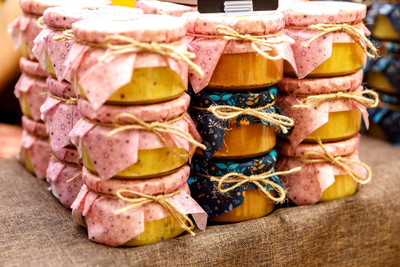Everything for preserving
Posted by The Wares Team on 8th Jul 2020
We’ve talked in recent blog posts about how the current Covid-19
pandemic and subsequent lockdown have brought about some perhaps
unexpected changes in the way that people think about the food they eat,
where it comes from and how secure that supply chain really is.
With a reluctance to go out shopping too often and widespread shortages,
especially in the early days of lockdown, more and more people have
started to consider how they can ensure that they have plenty of food in
store to feed their families, without the thoughtless stockpiling that
was seen at the beginning of the crisis. Having more time on our hands
generally has also meant that more and more of us have started to
consider home preserves as a strategy for reducing our reliance on
supermarket shopping.
Whilst preserving in all its forms is fairly simple to get into, having
the right preserving equipment can make life a lot easier for the home
preserves enthusiast and there are plenty of specialist tools for those
that want to take things further. In today’s blog post, we thought we
would run through these tools and accessories, to provide an outline of
what you need for each different type of preserving project.
What preserving equipment do I need?
The answer to this question really depends on what you want to preserve.
Since most people start their home preserves journey with a batch of
jam, let’s look at the typical jam making equipment basics. One of the
best items to start with is a good maslin pan. Maslin pans are solid and
robust, with a thick base, a pouring lip, and a swing handle. Many are
marked with a measuring scale inside the pan so you can see exactly how
many litres of liquid you have in the pan. Choose a pan that you will be
comfortable lifting - if weight is an issue, there are smaller pans
available, but obviously, you will only be able to make smaller batches
of jam in a smaller pan.
Another key piece of jam making equipment is a jam thermometer. Your
Grandma probably taught you how to tell if your jam had reached setting
point by using a plate that had been chilled in the freezer, but for a
more accurate and reliable method, a jam thermometer is essential. These
thermometers usually have a clip so that they can be fixed to the side
of your maslin pan, and a large face so that you can see the temperature
easily. With a proper jam thermometer, there’s no second guessing with
the set - your jam has either reached 105°C or it hasn’t!
The next bit of jam making equipment that is guaranteed to make your
life easier is a jam straining kit. This is essential if you want to
make perfectly clear jellies as well as jams and it will also come in
handy if you branch out into making elderflower cordial, for example.
There are lots of other preserves that benefit from straining, so this
little item will soon repay the investment.
The final gadget that will appeal to jam makers is a jam funnel. It can
be hard to tip a heavy maslin pan accurately to pour your jam into jars,
so a jam funnel is the answer. It will keep your jam away from the
sides of your jam jars, ensuring a perfectly neat and non-sticky finish
and a professional look.
As we’ve said before in our blog, the finishing touches really do make a
big difference with home preserves, so it’s important to think about
things like labels and lid covers. These are available in all sorts of
colourful designs and they can really make your jams and chutneys stand
out from the crowd. If you’re thinking of giving some jars of your own
homemade produce as gifts to friends and families, spending some time
and effort on the presentation will be even more worthwhile.
Don’t forget the jars and bottles
Whether you’re rustling up a batch of strawberry jam or making some
delicious elderflower cordial, you will always need plenty of good
quality jars and bottles. Instead of re-using shop-bought jars and
bottles, invest in a good range of jam jars, sauce bottles and drinks
bottles. Using a consistent style of jar or bottle, all with nice clean
lids, will make a real difference to your sense of achievement and
satisfaction - we guarantee it.
Whilst jams are usually made in 1 lb jars, there are all sorts of other
shapes and sizes available that suit other preserving projects. Honey is
often presented in hexagonal jars for example, and jellies that are
intended for serving with cold meats and cheeses are often made using
slightly smaller jars, to account for the fact that it generally takes
longer to use up a whole jar.
Are you a recent home preserves convert? What preserving equipment have
you found to be indispensable, and what bits of kit are on your shopping
list? Share your stories via Twitter, Facebook or Instagram...

